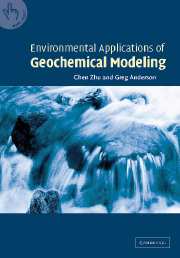Book contents
- Frontmatter
- Contents
- Preface
- 1 Introduction
- 2 Model Concepts
- 3 Thermodynamic Background
- 4 Computer Programs for Geochemical Modeling
- 5 Preparation and Construction of a Geochemical Model
- 6 Speciation and Solubility Modeling
- 7 Modeling Surface Adsorption
- 8 Reaction Path Modeling
- 9 Inverse Mass Balance Modeling
- 10 Coupled Reactive Transport Models
- 11 Kinetics Modeling
- Appendix
- References
- Index
5 - Preparation and Construction of a Geochemical Model
Published online by Cambridge University Press: 27 March 2010
- Frontmatter
- Contents
- Preface
- 1 Introduction
- 2 Model Concepts
- 3 Thermodynamic Background
- 4 Computer Programs for Geochemical Modeling
- 5 Preparation and Construction of a Geochemical Model
- 6 Speciation and Solubility Modeling
- 7 Modeling Surface Adsorption
- 8 Reaction Path Modeling
- 9 Inverse Mass Balance Modeling
- 10 Coupled Reactive Transport Models
- 11 Kinetics Modeling
- Appendix
- References
- Index
Summary
Introduction
To set up a geochemical model, we need:
specific information describing the geological system of interest;
conceptualization of what chemical reactions are occurring and what chemical reactions are important to the questions we seek to answer;
thermodynamic, kinetic, and surface properties for the specific chemical system.
Establish the Goals
The goals of geochemical modeling will determine what type of models to develop and how detailed they need to be. They also determine what samples to collect and what parameters to measure. The purposes can range from establishing the baseline geochemistry or background concentrations, predicting contaminant fate and transport, and evaluating remedial alternatives. Usually, no matter what the ultimate goals are, there is a need to use geochemical modeling to characterize the dominant water-rock interactions at a site.
Learn the Groundwater Flow System
Some basic knowledge of the directions and rates of groundwater flow at a site is important for deciding the sample collection and model conceptualization. The direction of groundwater flow determines the sequence in which the water will contact different mineral assemblages in the aquifers. Knowledge of the flow path ensures that observed chemical variation results from a evolutionary path, and this variation can be used in our conceptualization of chemical reactions in an aquifer. For example, knowledge of the flow paths is essential for the application of inverse mass balance modeling (see Chapter 9). The rate of groundwater flow determines, for example, whether or not the local equilibrium assumption can be applied.
Information
- Type
- Chapter
- Information
- Environmental Applications of Geochemical Modeling , pp. 92 - 105Publisher: Cambridge University PressPrint publication year: 2002
